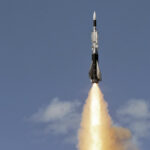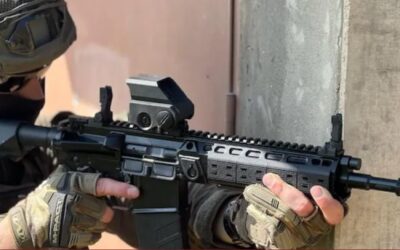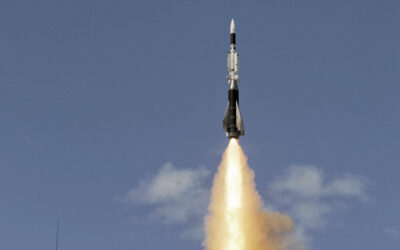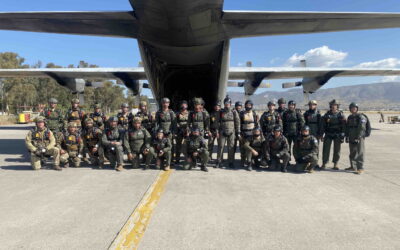The US Space Force has unveiled its new Remote Modular Terminal (RMT) weapon system. The system has completed its…

To date, nearly 1,000 F-35 aircraft have been delivered worldwide.
Each F-35, according to BAE Systems, is equipped with an integrated electronic warfare (EW) system, providing 360-degree, full-spectrum situational awareness and rapid response capabilities, enabling the aircraft to evade, target, counter, and jam threats as well as approach targets with strong defences.
The F-35 aircraft, which is expected to remain in service until 2070, is designed with continuous upgrades so that it can overcome threats that will arise during its sixty-year service life.
As part of a broader strategy focused on achieving effective missions throughout the aircraft’s lifespan, the US Department of Defence has entrusted BAE Systems to design and build the “Block 4” version, which is the next generation of the E/W AN/ASQ-239 system.
According to the company, its engineers, manufacturers, and program teams are working hard to keep the F-35 ready against evolving electromagnetic threats.
Operational environment
The fight is no longer the same. The environment in which the F-35 must operate is contested, which means the aircraft’s pilots should not expect their freedom to carry out their missions unopposed. From the US perspective, this translates into the presence of electromagnetic threats capable of detecting aircraft as well as neutralizing and jamming electromagnetic signals, i.e. the energy waves used for communication, navigation, and targeting.
Also read: BAE Systems | PHASA-35 completes first successful stratospheric flight – Photos & VIDEO
The electromagnetic environment is also congested with civil, commercial, and even friendly military signals that make it difficult to isolate and detect threat signals. At the same time, advanced threat systems attempt to evade detection by various means, including the use of networked signal transmitters, complex pulse patterns, and adaptive waveforms.
As the number of simultaneous threats increases, so does the complexity of the battlefield. The ability to communicate, navigate, and target using electromagnetic energy allows the Armed Forces to locate, track, and engage targets. The US focuses on providing the ability to attack targets, which opponents lack.
In the most demanding environments, F-35 pilots will face well-equipped adversaries nearly at their level and with advanced E/W capabilities. To survive and carry out their missions, they need stealth technology (i.e. low observability by radar) and situational awareness (i.e. identification and geo-location of air defence systems, enemy aircraft, and incoming missiles).
When mission survival and success depend on the integrity of operating capabilities in the electromagnetic spectrum, having cutting-edge IT capabilities is critical. One of the most important aspects of the AN/ASQ-239 system is its ability to detect a wide range of electromagnetic signals in a 360-degree sphere around the F-35 at long range.
In particular, it detects signals passively without emitting energy, thus making the F-35 itself less observable by adversaries. The systems’ “staring” sensors are embedded throughout the aircraft, enabling immediate detection of electromagnetic signals, providing pilots with critical situational awareness, and allowing them to act first. Overall, thanks to its long-range and wide-spectrum (360-degree) E/W capabilities, the F-35 E/W system also increases the likelihood of signal interception.
Mission needs – rapid response
“Block 4’s AN/ASQ-239 system is designed to detect any relevant threat pulse as soon as it occurs,” said Lisa Aucoin, Vice President of BAE Systems’ F-35 Solutions division. The company focuses on providing effective situational awareness, which enables rapid response to multiple simultaneous threats. In combat, situational awareness is often the catalyst that enables a return to base.
In today’s world of contested and saturated airspace, it is vital to detect enemy electromagnetic activity from as far away as possible, regardless of its orientation, wavelength, or cloaking capabilities employed.
The key to survival is rapid response to these signals – exactly what the AN/ASQ-239 system is designed to do in the Block 4 version.
Also read: BAE Systems | Delivery of next-generation digital IFF systems for the US Navy
The Future Fight – Overpowering and Neutralizing the Evolving Threat
BAE Systems’ Block 4 E/W systems will include significantly upgraded hardware and software that improves signal detection and processing capabilities. The new high-performance sensors will enhance the system’s ability to detect threats that are difficult to observe as well as a greater number of simultaneous threats.
The F-35’s E/W system was designed to provide dominance in the electromagnetic spectrum, but it is also a force multiplier. Also, the situational awareness provided can be shared with friendly forces.
Along with promoting the Block 4 version capabilities for the F-35, the company is also promoting the Eagle Passive Active Warning Survivability System (EPAWSS) for the F-15 fighter jets. At the heart of its systems is the Storm EW™ spectrum warfare suite, which operates on any platform, with proven common modules that enable faster delivery of IT capabilities through software and firmware upgrades across fleets, reducing engineering costs and life cycle costs.
As the company emphasizes, BAE Systems teams are working to ensure that the US and its allies dominate the spectrum and have US capabilities available at the speed of need.
READ MORE
ASCANIO | Made-in-Cyprus Mixed Reality training
https://defenceredefined.com.cy/ascanio-made-in-cyprus-mixed-reality-training/Technology is advancing at an accelerated pace and so do the training requirements of those holding high-risk positions.
IWI | Introduces Micro Folding Battle Sights to enhance Co-Witness capabilities
IWI (Israel Weapon Industries), a member of the SK Group, has unveiled its new Micro Folding Battle Sights (MFBS).
Russia | Cluster bombs hit residential area in Odessa
Images from Russia’s strike in the heart of Odessa, which hit the so-called “Harry Potter Castle”, a former politician’s mansion now…
France | Industries prioritize orders of anti-aircraft missiles
The Armed Forces Ministry of France has instructed industries involved in the production of Aster anti-aircraft and anti-ballistic…
Ecuador | Appeals to International Court of Justice denouncing Mexico
Ecuadorian police stormed the Mexican embassy hours after the Mexican government granted former Vice President…
Remote Modular Terminal | The US Space Force’s new weapon system
The US Space Force has unveiled its new Remote Modular Terminal (RMT) weapon system. The system has completed its…
Latvia | Citizens are asked to turn basements into air raid shelters
Latvian authorities have called on citizens to turn their basements into air raid shelters, causing concern.
HNDGS | Greece – USA bilateral exercise “STOLEN CERBERUS XI” – Photos
From Monday 15 to Friday 26 April 2024, the bilateral exercise “STOLEN CERBERUS XI” took place under the coordination…




















